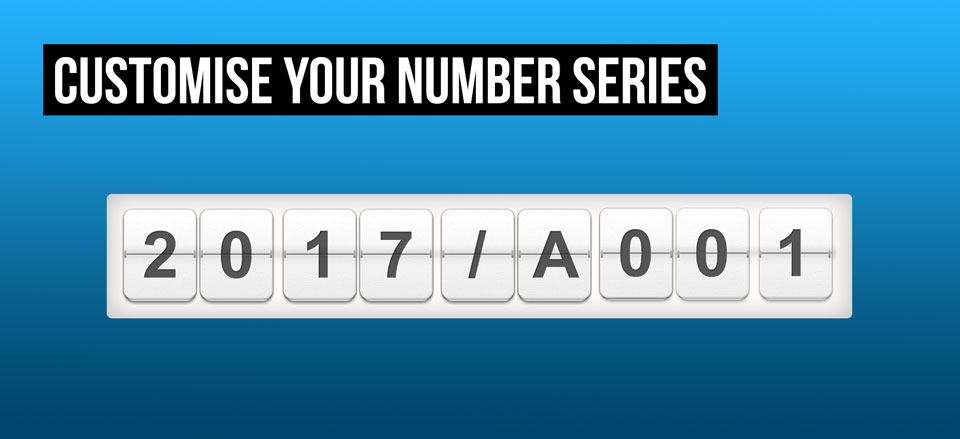Here at Debitoor, we always take suggestions from our users into account. And occasionally there is a particular request that inspires our developers to take action to meet the needs of our users. In this case, we’ve now introduced the possibility to add custom, alphanumeric number series for your invoices, quotes, and delivery notes.

What do we mean by alphanumeric invoice numbers?
This means that your invoice, quote and delivery note numbers can now include letters, as well as other characters! While this may sound like the sky’s the limit, your invoice number sequence should still allow your invoice numbers to progress sequentially, without any gaps or repeats.
The new invoice number possibilities also mean that you can separate letters and numbers by other characters such as slashes (/) or dashes (-), and can still see your invoice numbers count up sequentially if you enter them correctly the first time. For our suggestions on the best formats to use in Debitoor, keep reading.
What invoice numbers should I use?
Now that you have a series of different options available, it’s worth taking a moment to come up with a system for numbering your invoicing that makes sense for your records and also for your accountant, for example.
The invoice number series that you choose should allow for the possibility to count up from the first invoice that you create. Legally, your invoice numbers must be sequential, which means that if it is your first invoice, it should include the number ‘1’.
However, beyond that, there are several ways to customise the format to provide you with more information when handling your records. For example, you could choose to include the accounting year as well as the month. Or, you could have a couple of letters you would like to use to indicate a certain business.
Sample custom invoice numbers (that work well in Debitoor!)
Now we’re getting to how your invoice numbers can be structured. Many users have requested the possibility to include different dates to reference their accounting or calendar years.
A simple invoice number series example that would reflect this could include:
- 2017/001
- 2017-001
- 17/001
- INV-001
- QUT/001 (For quotes!)
These number series show the current year, and also provide room for the number sequence to count up to the triple digits (under 1000 invoices) for example. If you estimate that you’ll have more than 1000 invoices in the year, consider adding another ‘0’.
If you’d also like to include months, that’s easily done following the same format as above. What about letters, you ask? Letters can be added to the invoice number sequence and will remain unchanged as the numbers progress. For example:
- 2017/INV/001
- 17-QUT-001
For more suggestions on how to structure your invoice number series, check out our short video that also shows you just how easy it is in Debitoor invoicing software.
What if I want to reset my invoice numbers each year?
That’s the easy part. Once you have your number series selected, moving to a new year means you can easily reset your count to ‘1’. For example, on January 1st, 2018, you can change your invoice numbers to:
- 18/INV/001
Just by typing it into the ‘Invoice No.’ field in a new invoice. And yes, the system will then automatically count up from there. Your next invoice will be ‘18/INV/002’. Check out our tutorial for a step-by-step guide on 'How to change your invoice number series'.
Why alphanumeric invoice numbers?
While many users stick to the straightforward invoice numbers and opt to start with ‘1’, invoice number sequences can quickly become complicated and messy when you start adding credit notes, or if an invoice needs editing, or simply if your business begins to grow quickly.
For this reason, and for organisational purposes (especially when it comes time to file tax returns), using letters and other characters can provide you with a clearer idea of when and for what your invoices were created.
When should I update my invoice number series?
As we’ve mentioned, it’s important that your invoice numbers are sequential, meaning no jumps in numbers and no duplicate numbers. With Debitoor, this is easy as the software automatically applies the next available invoice number in your sequence and never uses the same invoice number twice.
But if you’ve already started with a solely numerical sequence such as ‘17001’ or even ‘1’, you might be wondering how to switch to a new number sequence that takes advantage of the alphanumeric possibilities.
The best advice is to wait until the end of your accounting period. But the most important thing is to ensure your invoice number sequence has no holes or repeats. This means that if you’re working with invoice ‘052’ one day and want to switch your number series, make sure your next invoice is, for example ‘17-INV-053’.
